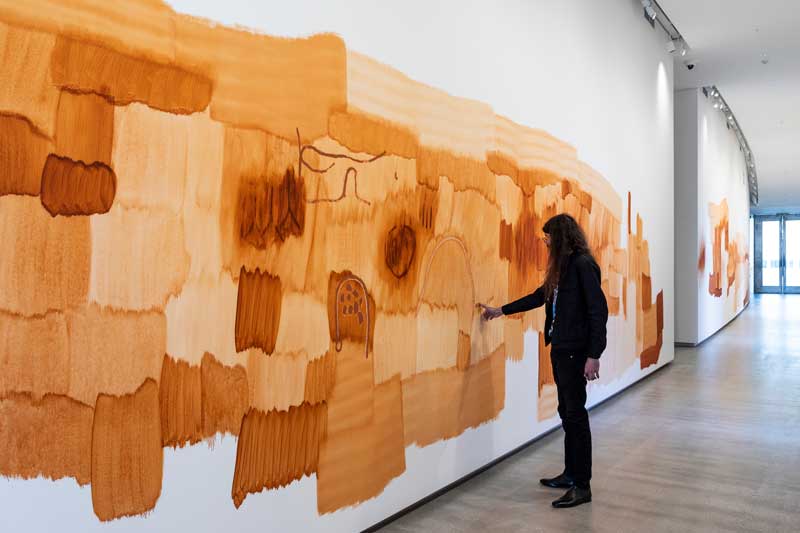
This year’s edition of the TarraWarra Biennial, From Will to Form, curated by Melbourne-based independent curator Emily Cormack presented the work of 24 artists (including one collective) in what could be viewed, in many of the works, as blending central tenets of late modernism – of formalism and psychoanalysis – with new materialist ideas that emphasised a dynamic materiality and focus on land. The curatorial premise took its cue from Gilles Deleuze, in particular his reading of Nietzsche. “Will to form” is a riff on “will to power.”
Cormack contends following Deleuze that the “will to power” is a generative force innate in human nature, which drives all doing in the world. This is harnessed by artists who inject their “will” into their artmaking practice, resulting in “affective force” that “overflows” from the artworks that she was drawn to. The exhibition was heavy on sculpture but also included photography, painting, installation, and performance, which were divided into the regions from where Cormack maintains the artists’ will derives. That is, will, in and of the body; in and of the land/matter; in and of the psyche; in and of itself; and in and of states of release.
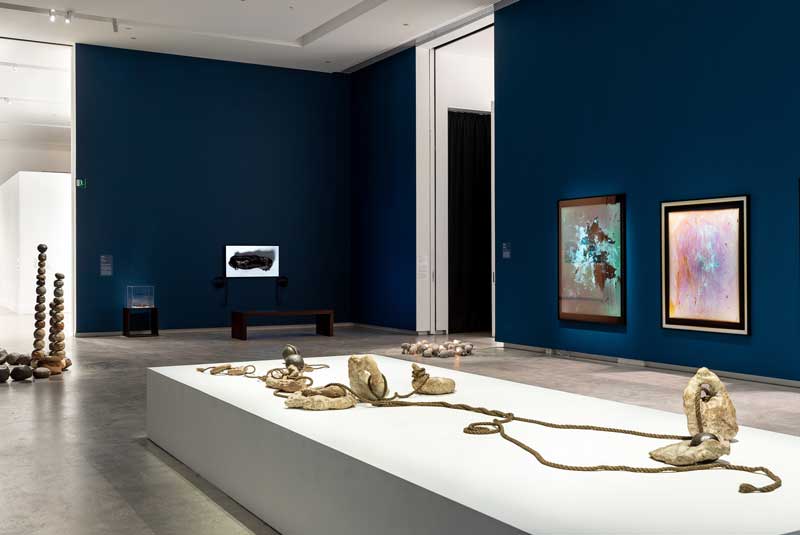
Cormack’s harnessing of Deleuze and the notion of an indistinct force as a guiding principle too, was a similar mode of curating to Harald Szeemann’s mythical “Museum of Obsessions” from which his physical exhibitions derived. Szeemann defined “obsessions” as a “welcome, albeit pre-Freudian, unit of energy” that drives creative practice and he is stated as interested in “the obsessive energies that lie behind the making of the work of art as opposed to its material and formal outcomes.”[1]
This mode of curating frames art outside of conventional categories and is sometimes deemed as the curator acting as “auteur”. The exhibition texts were supported by a raft of literary and poetic references, rather than a clearly articulated art-historical logic, and the accompanying catalogue essay was rife with fluid analogies – “these forces are our will, and they flow like water, running always, soaking, seeping, respiring and perspiring.”[2]
In looking at Deleuze’s aesthetic philosophy the connection to Cormack’s thinking becomes apparent. Deleuze believed that works of art were composed of sensations which were extracted from the rhythms of the earth, and therefore connected to a wider cosmic order. The “forces” Cormack takes as her foundational framing connect artwork to body to universe creating a totalising system, and places a charge within the artwork, similar to the spiritual element of twentieth-century modernism where a formalist artwork may be a conduit to a power beyond.
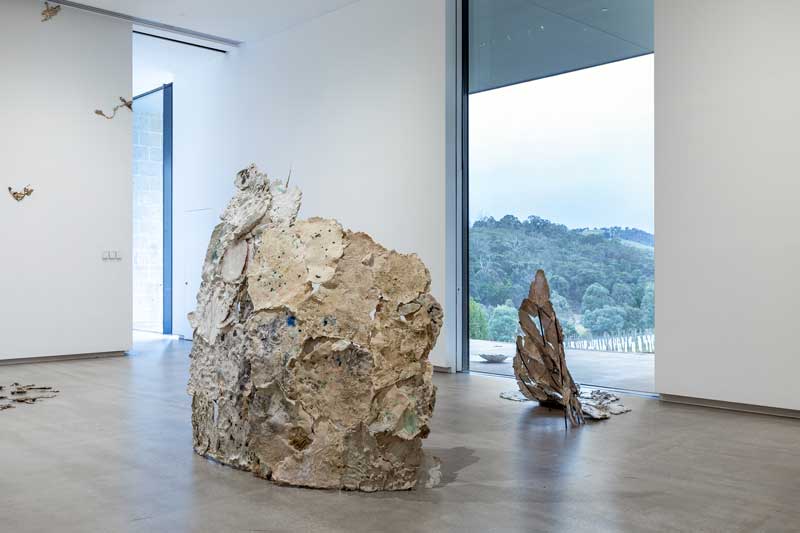
Within the exhibition, the notion of “forces” seemed channelled into the active materiality employed by most artists. I was reminded of A Material Turn, an exhibition curated by Rebecca Coates at Margaret Lawrence Gallery in Melbourne in 2015 which was an inquiry into how this largely theoretical movement held relevance to contemporary art, and many works in this exhibition included raw and organic materials. New materialism is a response to the traditional Marxist and material culture approach that views objects and materials as dead unless activated by humans.
In contrast to this, new materialism views matter as having an agency of its own: to quote the feminist theorist Karen Barad “where matter is understood as a dynamic and shifting entanglement of relations rather than a property of things.”[3] Cormack’s framing of the exhibition seemed to oscillate between both positions, she states “my understanding of this wilful energy was that it did not originate from the artist’s materials but was captured in them,”[4] but she then says, that in her exhibition-making, she wished to “begin with the object’s will, focusing on its force and tracking it’s path to form.” In this sense, the exhibition straddles individualistic twentieth-century notions of authorship, and recent ideas on dynamic materiality.
The sculptural installations by Isadora Vaughan and Lindy Lee which sat overlooking the north window of the gallery formed a fruitful synergy bound by formalism which reflected new materialist ideas. Vaughan’s sculptural work consisted of a medley of clay resembling a canker sore (like an ulcer), suggesting a weeping, oozing body expressed through an assortment of materials – such as dust, copper, and sand – which had been injected into the unfired clay with unpredictable results. This work contained an abject will, as it represented the wound described by Rosalind Krauss as “this undifferentiable maternal lining – a kind of feminine sublime,” composed of bodily fluids that are wound-like.[5]
Lee’s sculpture had a similar explosive force with forms that interacted with the outside world, but coming from a declared Buddhist position. Neither Choice, or Chance (2018) made of bronze that had been melted and flung against a hard surface presented fixed as fluid on the wall, and in the circle on the gallery floor. This process mirrored the Zen Buddhist calligraphic practices that Lee has so consistently drawn upon through meditation to clear the “self/ego” and allow the “will of the world” to “flow through them unimpeded,” as Cormack writes, connecting this Eastern tradition to her curatorial premise. The pairing of these works created an interesting relationship, combining different cultural viewpoints and harnessing different materials for their particular idiosyncratic charges supporting the “will to form” contention.
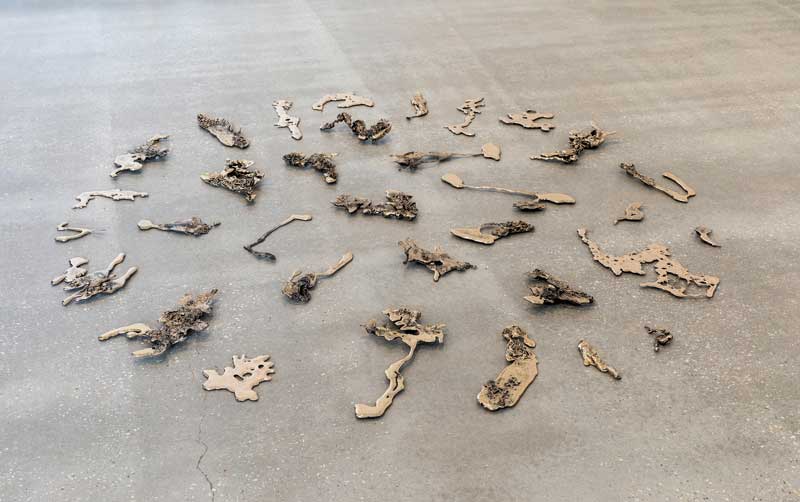
The central room, the “psyche” room, was painted a deep blue, a colour that Cormack said she deliberately choose to reflect this state. In the work of Justine Varga and Naomi Eller the unconscious was expressed through a likeness to art from the paleolithic era, bringing forth an alchemical force within these materials as a subconscious drive. Varga’s six chronomantic photographs appeared like illuminated walls of a cave each embedded with a rich jewel-like hue such as golden yellow, emerald green, sapphire blue, and peachy brown. Film has been marked and scratched, one by her grandmother’s phlegm, and then printed in large format transforming these bodily actions into pre-symbolic indexical mark-making. Sitting on a low plinth in the middle of the gallery, Eller’s sculptural works consisted of a series of weights, some circular forms in organic white clay, others round black balls, all with holes inside through which rope was threaded through connecting each discrete element of the work. Eller similarly sees the creation of these forms as coming from a deeper place of “precognitive human impulses” which take on the appearance of primordial objects, tools for an unknown, un-particular purpose.
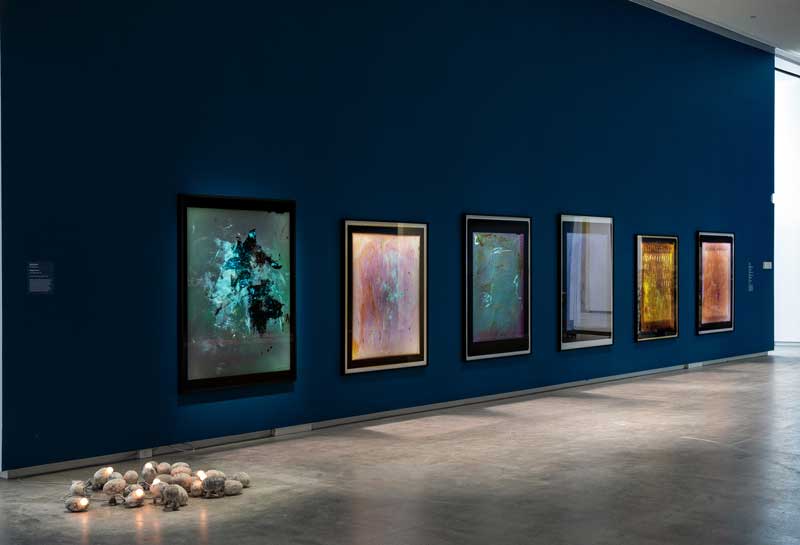
“Will in and of the body” had a similar sentiment of a psychologically charged formalism. This room was particularly crowded, with primarily abstract sculptural works resembling bodies jostling together in discordance. Sightlines were largely interrupted making it hard to view works in isolation. For example, at the exhibition’s main entrance point, looking into the room one viewed Rob McLeish’s large black sculpture Xenograft Couture (Rigged Composition in Black, 001) (2018) framed by Starlie Geikie’s body armour which hung outstretched on the wall. Cormack takes a literary/philosophical rational of these works as writing the body into form which comes from the feminist position of Hélène Cixous where she posits the body, in seeking release, as being written into language to “bring about a wider mutation of things.”[6] In certain works this translated a type of formalism infused with psychological undercurrents.
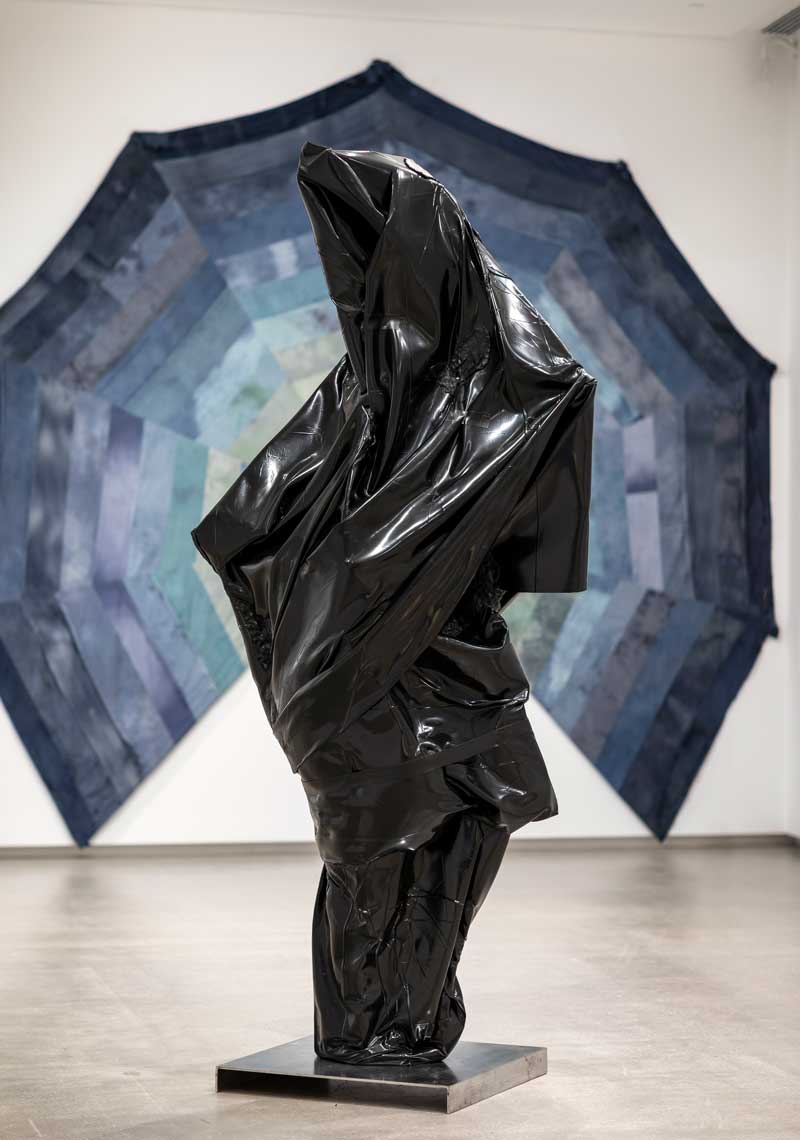
McLeish’s Xenograft Couture (Rigged Composition in Black, 001) (2018) had a likeness to Auguste Rodin’s Monument to Balzac (1892–97), showing the literary great in the midst of an epiphany. Yet here the figure is constrained by the epoxy resin strips cast from gymnastic mats giving the impression of an unconsciousness wrestling to escape, or a darker death drive seeking release. Conveying a similar sensibility, on view in a room to the side was the video work by Mike Parr, Black Milk of Mourning (2018), turning the body into a performative sculpture. This was an inverse of a previous work, White (2004–08), where the artist vomited white milk in what was described as the body’s rejection to the White Australia Policy. Here, the body is transformed into a formal entity of overflowing abjection and disgust, symptomatic of a violent response to humanity’s disgrace.
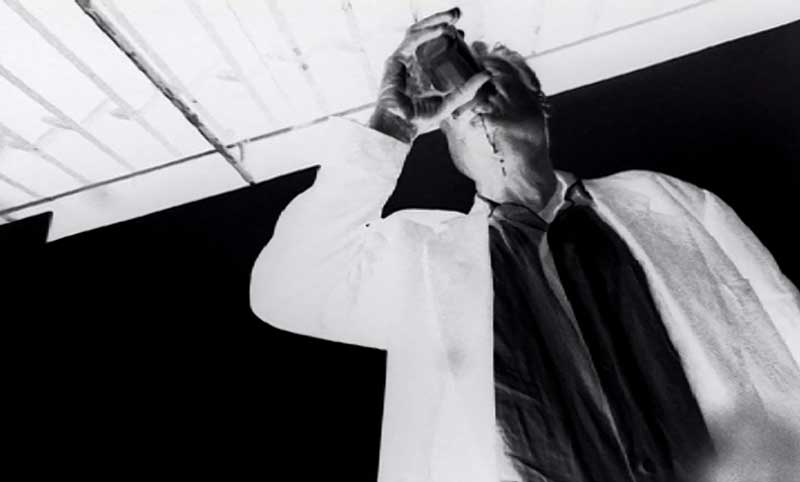
Cormack’s discussion of “Will in and of the land/matter” positions our relationship to the earth, stating that “humans are immanent with the earth, and for many this immanence is cellular as well as philosophical,”[7] a view that stems from Deleuze and his connection of art to the cosmos. And this western philosophical view bears resemblance to the Indigenous creation myths, as Cormack also notes in her catalogue text. Thus, as with the rest of the exhibition, contemporary Indigenous art was combined with Western artists that connected the land to being, conceived from different cultural positions. In Magnesite Norway (2016–18) the artist Kusum Normoyle and her collaborator Metter Rasmussen dress in black and film themselves performing in front of the Norwegian fjords in an act of extracting and playing the landscape’s internal forces with harsh vocals and a saxophone. This work was about the grandeur of the earth and how it is translated by humans through the body through music, which as Deleuze claims is the process of artmaking itself bound to rhythms from the earth.
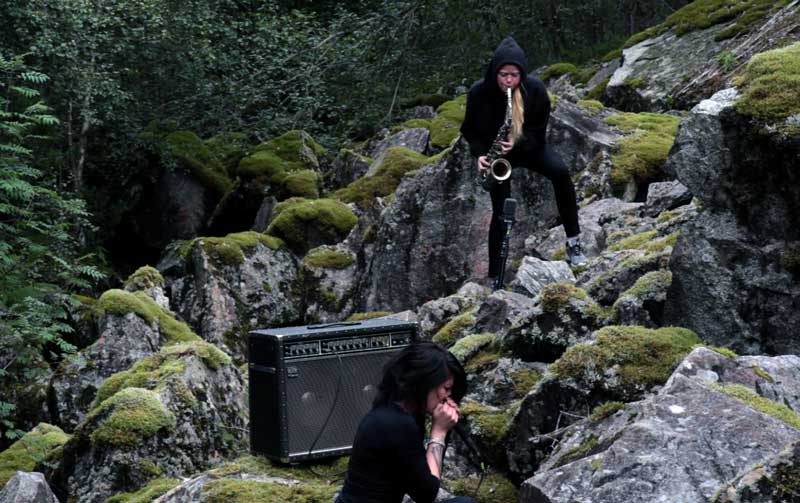
Dale Harding’s Wall Compositions from Memory (2018) similarly linked land to body (although this work was in the “Will in and of itself” category). Matter of the land as his primary material, chosen for its cultural significance, is processed through the body and overlaid with stories from different countries to create a new symbiosis. The work was made with his cousin Jordan Upkett and consisted of earth from Harding’s grandmother’s Garingbal country mixed with saliva (doubling Varga’s phlegm), which was then blown and rubbed into the museum’s wall. Marked into the pigment were stories and songlines from both Bidjara and Garingbal country in Queensland and the local Wurundjeri country upon which the TarraWarra museum sits. In incidences like these, when artmaking is conceived as a delicate play between the internal drive of the artist alongside their material and cultural agency, supporting relationships between and through the works, the exhibition was at its strongest.
Footnotes
- ^ Quoted in Doris Chon, “Harald Szeemann’s Museum of Obesessions, between parody and consecration”, in Harald Szeemann – Museum of Obsessions, Los Angeles: Getty Trust Publications, 2018, p. 95.
- ^ Emily Cormack, TarraWarra Biennial 2018: From Will to Form, TarraWarra Museum of Art, 2018, p. 7.
- ^ Quoted in Petra Lange-Berndt (ed.), “Introduction, How to be Complicit in Material”, in Materiality, Documents of Contemporary Art, London: Whitechapel Gallery; Cambridge, Massachusetts: The MIT Press, 2015, p. 17.
- ^ Emily Cormack, TarraWarra Biennial 2018: From Will to Form, TarraWarra Museum of Art, 2018, p. 7.
- ^ Rosalind E. Krauss, “The destiny of the Informe”, in Yves Alain Bois and Rosalind E. Krauss (eds), Formless: A User’s Guide, New York: Zone Books, 1997, p. 238.
- ^ Emily Cormack, TarraWarra Biennial 2018: From Will to Form, TarraWarra Museum of Art, 2018, p. 7.
- ^ Emily Cormack, TarraWarra Biennial 2018: From Will to Form, TarraWarra Museum of Art, 2018, p. 7.












